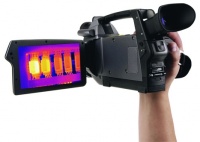Heat-seeking vision
Infrared systems are being used to identify problems in a variety of commercial applications

Recent advances in infrared thermography systems used by the police and armed forces have opened up a wide range of condition-monitoring capabilities in the commercial sector.
From detecting swine flu to diagnosing problems with electronics, the technology has become an indispensable tool for monitoring and diagnosing problems in an ever-increasing range of industries. Conservative estimates indicate an average saving of £7 derived from every £1 invested in the technology, and the latest range of cameras is set to increase this figure.
Currently, most infrared thermography systems can provide image temperatures from -20°C to +500°C, with accuracies of around ±2% at 30°C. They work by recording the infrared radiation emitted by objects, which increases with the temperature.
In defence, the cameras are used to detect human-sized targets at a distance of about 20km or during coastal surveillance tasks for the detection of vessels. However, a growing need to improve their accuracy and range is driving the next generation of condition-monitoring systems.
Register now to continue reading
Thanks for visiting The Engineer. You’ve now reached your monthly limit of premium content. Register for free to unlock unlimited access to all of our premium content, as well as the latest technology news, industry opinion and special reports.
Benefits of registering
-
In-depth insights and coverage of key emerging trends
-
Unrestricted access to special reports throughout the year
-
Daily technology news delivered straight to your inbox










Water Sector Talent Exodus Could Cripple The Sector
Maybe if things are essential for the running of a country and we want to pay a fair price we should be running these utilities on a not for profit...